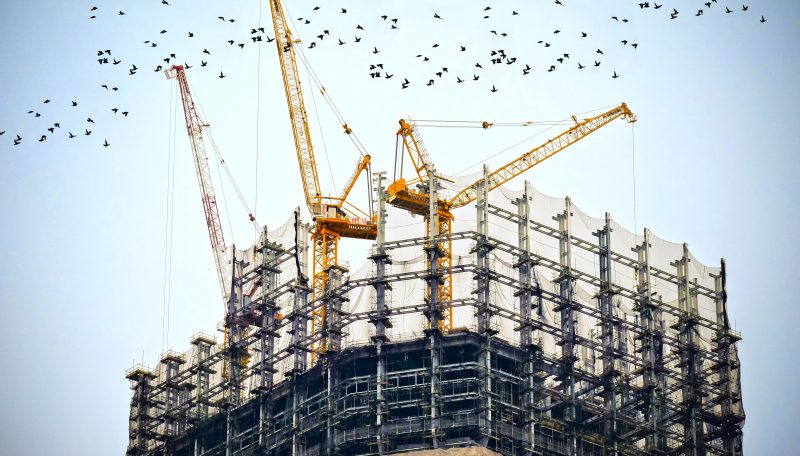As with most industries, technological advancements continue to be at the forefront of construction, shaping the future of the industry. To accommodate the constantly changing demands of modern businesses, technology continues to evolve at a rapid speed. For businesses to stay relevant in a highly competitive digital landscape, it is vital to keep up to date with the latest technological trends, and the construction industry is not an exception. From BIM to Virtual Reality, this article explores the top rising technology trends in the construction industry.
BIM
BIM technology is an intelligent system that supports construction professionals by combining data capture within a large structure of construction processes, allowing effective planning, designing, modifying and management of buildings and their infrastructures. BIM develops 3D models and enables document management and coordination throughout the entire life cycle of a project.
BIM technology in construction significantly improves collaboration, as it integrates people and information together; allowing everyone who is working on the project to contribute their expertise onto one model. This allows the project to be reviewed and improved in real-time. Compared to using 2D drawings in construction, the use of BIM during a project increases efficiency and reduces waste.
It is predicted that BIM features will be further developed, alongside subsequent technology, which will continue to shape and change all aspects of construction projects, including project design, development, deployment, and project management.
Despite BIM hosting a huge variety of benefits for construction projects, its adoption rate in the construction industry has been lower than expected. However, the adoption of BIM technologies has started to increase at a faster rate over the past few years, and those who fail to incorporate this technology into their projects are at risk of having a disadvantage against competitors in a highly competitive sector.
If you are interested in finding out more about BIM surveys, see our benefits of BIM surveys blog, or contact our specialists to find out how BIM can help your construction needs.
Artificial Intelligence (AI) and Machine Learning (ML)
Artificial Intelligence (AI) is intelligence, which is shown by a computer or machine, mimicking human behaviour. Machine Learning (ML) is a subset of AI that involves the use of algorithms to learn from data, identify patterns and make informed decisions. This technology is already in use in the construction industry and is continuing to have the largest impact on the sector. ML is helping to advance technology within the industry, with a focus on finding solutions that aim to maximise cost and speed efficiencies.
With construction projects generating a vast amount of data, AI can collect this past data and use it to enhance the machine learning capabilities and then predict the outcome of projects in the future, whilst also mitigating potential risks. However, a current issue that AI is facing in construction is identifying a way to collect and structure the data that is constantly being generated.
Whilst AI and ML have already started to change the construction industry, the possible benefits that can be achieved from AI and ML include:
Increased productivity – AI can be used to power machines in the construction industry so that they can perform repetitive tasks, which can improve productivity and reduce the occurrence of errors. In addition, AI can also be used in construction for planning and scheduling, whereby AI can simulate projects and deliver the most suitable schedules that maximise efficiency and productivity, which in turn will reduce cost and time.
Increased safety – AI can be used within construction to monitor potential safety hazards, such as identifying whether staff are wearing PPE, using equipment correctly and alerting workers of potential dangers. Additionally, AI could also be used to optimize risk assessment and mitigation processes, improve building designs and forecasting, which will improve safety across construction sites.
Improved Financial Planning and Project Management – by using past data, AI has the ability to predict realistic timelines, identify potential cost overruns and reduce onboarding times for staff.
Enhanced Design of Buildings – AI and machine learning can enhance the design of building as they can develop a variety of solutions and design alternatives, which all take mechanics, electrics, and plumbing works into consideration.
Virtual Reality and Artificial Reality
Virtual reality (VR) and artificial reality (AR) technologies are becoming increasingly recognised as game-changer within the construction industry. The difference between VR and AR is that VR involves a complete immersion experience, which removes the physical world, whereas AR involves adding digital elements to the physical world.
In conjunction with BIM technologies, the potential of VR and AR technologies in the construction industry are endless. VR/AR features enable BIM building models to come to life, providing the ability to walk through and around the model. However, this is only a small aspect of the potential of VR/AR for the construction industry, and there are a huge range of benefits that can be achieved from using it, some of these benefits include:
Improved collaboration – VR and AR can provide teams with the ability to work on the same project whilst being in a different location, optimising project productivity through improved collaboration.
Reduced Costs – Having virtual walk-throughs of projects in the initial design phases enables clients to identify areas of the design they want to be changed and making these changes in the early stages reduces the cost of making these changes further into the project.
Improved Health and Safety – VR and AR has the capabilities to identify potential risks and safety breaches of a construction project, by performing hazard simulations and clash detections. These technologies can also be used to improve staff safety training, as well as support supervisors, managers, and inspectors and clients.
Robotics and Drones
In comparison to other industries, the construction industry is significantly less automated, with the primary source of productivity being manual-intensive labour. The lack of automation is due to the fact that robots require controlled environments that involve no variables and repetitive tasks.
However, as the construction industry continues to evolve in terms of technological advancements, the use of robotics and drones will continue to rise. Some examples of how drones and robotics can be used in the construction include:
Improved Safety – Drones can be used to monitor sites and identify potential risks and allow managers to view the site without having to be there in person.
Enhanced Productivity and Quality – Robots can be used to replace repetitive tasks, such as bricklaying to improve efficiency and quality of work.
Technological advancements in the construction industry are expected to continue at a high speed throughout 2022. At Landform Surveys, we always use the latest technology to perform our surveys for clients. Find out more about how our services, such as drone surveys and BIM surveys, could transform your construction project.


